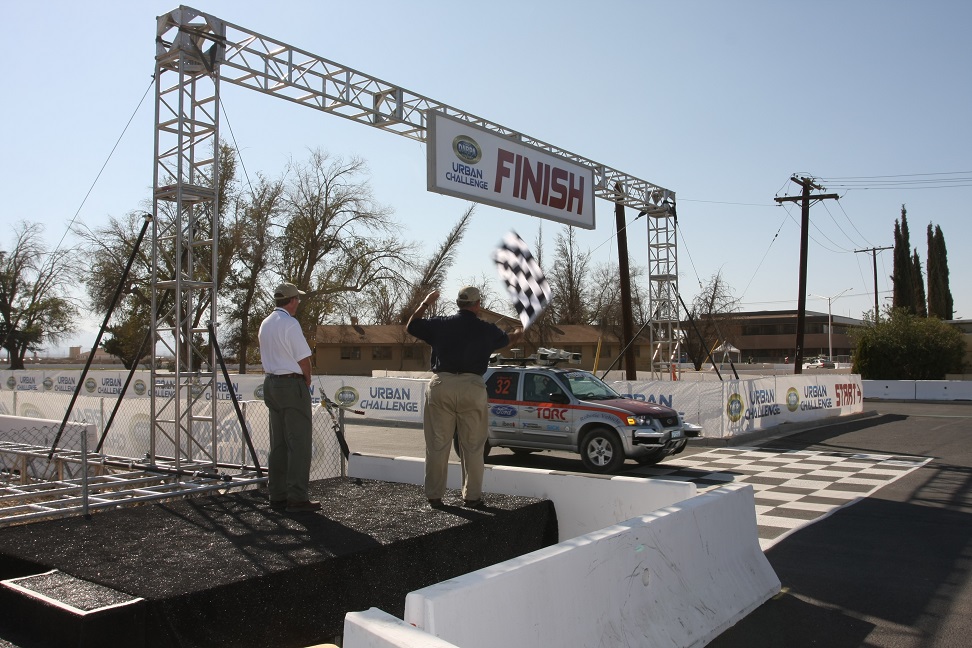
Unmanned systems have come a long way in recent years, from Unmanned Aerial Vehicles (aka. UAVs/drones) to armed robotic rovers. However, in its ongoing drive to “unman” the front lines, the US Armed Forces and DARPA are looking to develop machines that are capable of operating in combat zones and hazardous areas without the aid of a remote operator.
Crowdsourcing Advancements in UAVs
In short, the next step is towards the development of autonomous systems, where robotic systems could eventually replace human drivers in hazardous military operations - such as supply convoys. Towards this end, DARPA established the Grand Challenge in 2004, an incentive program designed to spur the development of technologies needed to create the first fully autonomous ground vehicles.
While many challenges have been established since that time, the Grand Challenge was DARPA’s first major attempt to use a prize-based competition to attract developers and encourage collaboration across diverse fields. The first Challenge – which took place on March 13th, 2004 – involved 15 self-driving ground vehicles navigating a 228 km (142 mile) course across the desert in Primm, Nevada.

The Goal and Results of the Grand Challenge
The first team to pass a series of qualification tests and then complete the test course in less than the prescribed ten-hour time limit would receive a $1 million cash prize. Unfortunately, the rugged desert course, plus the technological hurdles involved, proved to be too much for the teams involved. None finished the course and the prize went unclaimed.
However, that first competition did manage to establish a community made up of innovators, engineers, programmers and developers who were united by a common goal. As Lt. Col. Scott Wadle, DARPA’s liaison to the U.S. Marine Corps, said of the people involved: “The fresh thinking they brought was the spark that has triggered major advances in the development of autonomous robotic ground vehicle technology in the years since.”
For the second event – which was held on October 8th, 2005 in southern Nevada – things went a little better, with five of the original 195 teams completing the 212 km (132 mile). Stanford University’s entry, “Stanley" (shown below), managed to finish first with a time of 6 hours and 53 minutes, and won the $2 million prize.

By the third event, held in 2007, DARPA extended the initial challenge to include autonomous operations in a mock urban environment. This event was known as the DARPA Urban Challenge, which was held on November 3rd, 2007, at the former George AFB in Victorville, Calif. Here, teams were required to build an autonomous vehicle capable of driving in traffic and performing complex maneuvers such as merging, passing, parking and negotiating intersections.
Whereas the previous challenges were more physically demanding for the entrant's vehicles, the 2007 Challenge presented numerous additional challenges as far as navigation software was concerned. Here, designers were required to build vehicles that were able to obey all traffic laws while they detected and avoided other robots on the course - something that rarely happened at the previous challenges.
Tartan Racing, a team from Carnegie Mellon University in Pittsburgh, Pennsylvania, claimed the $2 million prize with their vehicle "Boss", a Chevy Tahoe. The Stanford University Racing Team claimed the second place prize of $1 million with their "Junior" vehicle - a 2006 Volkswagen Passat. Coming in third place was team VictorTango of Virginia Tech, winning the $500,000 prize with their 2005 Ford Escape hybrid, "Odin".

Other DARPA Crowdsourcing Challenges
Since that time, DARPA has created three other challenges that build on the Grand Challenge's prize-based competition model. These include the Spectrum Challenge, the DARPA Robitics Challenge (DRC), and the Cyber Grand Challenge (CGC) - programs which seek to foster the development of radio communications, emergency-response robots, and automated network defense systems.
Today, some ten years later, DARPA points to the proliferation of defense and commercial applications as indications of the Challenge’s success. Examples of defense applications include the Oshkosh Defense TerraMax unmanned ground vehicle developed for the Marine Corps. In addition, TORC Robotics, one of six finishers of the Urban Challenge, continues to develop autonomous capabilities for Marine Corps vehicles.
In the commercial realm, autonomous systems have been developing all the more conspicuously, with examples ranging from Google’s self-driving car program, the Hyundai Motor Group’s Future Automobile Technology Contest, and General Motor’s Electric-Networked Vehicle (EN-V, shown below). Given the current rate of development, it is likely only a matter of years before a significant portion of vehicles on the road are driven by robotic, autonomous systems.

Why UAV's?
The advantages of having autonomous vehicles both on the road and in hazardous areas are quite obvious. In the former, it means greater convenience, coupled with the reduced risk of impaired driving and accidents caused by being "asleep at the wheel". In the latter, it means convoys and combat vehicles that are able to sweep through territories where the likelihood of insurgent attacks and IEDs are high, without putting human lives at risk.
In addition, its pure science fiction gold! Much like flying cars, the promise of self-driving cars is something that many of us who grew up in the 20th century were told to expect by now. Thanks to programs like the Grand Challenge, another decade may be all it takes for us to finally see this dream come true...
And be sure to check out this video of the 2005 Challenge, courtesy of MyRide on Autobytel:
Sources:
- www.pbs.org/wgbh/nova/darpa/
- archive.darpa.mil/grandchallenge/
- www.defense.gov/news/newsarticle.aspx?id=65077
- www.darpa.mil/newsevents/releases/2014/03/13.aspx
- www.darpa.mil/Our_Work/TTO/Programs/Adaptive_Vehicle_Make__%28AVM%29.aspx
- www.navsea.navy.mil/nswc/dahlgren/NEWS/Marine_Mobility/Marine_Mobility.aspx
- www.popsci.com/cars/article/2013-09/google-self-driving-car
- www.hyundaimotorgroup.com/MediaCenter/News/Press-Releases/HMG-autonomous-vehicle-contest-141002.hub#.VLV75HtFW-c
Image Credits:
- Top Image: DARPA
- 2013 Grand Challenge: DOD
- Stanley: stanford.edu
- 2008 Urban Challenge: DARPA
- GM EN-V: media.gm.com








